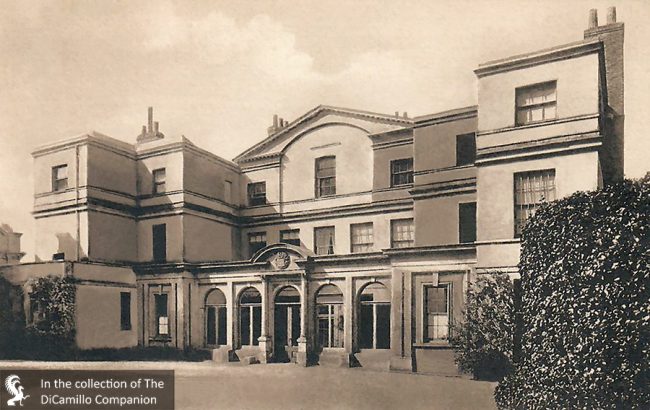
The house from a circa 1901 postcard
Earlier Houses: There have been houses on, or near, the site of the current house since at least the 14th century. Elements of the last of these, a circa 1630 Dutch style house, were incorporated into the current house.
House & Family History: In 1686 Sir William Temple purchased the estate and renamed it Moor Park in honor of the Hertfordshire house of that name, whose gardens he admired. All that survives of the house that Sir William purchased are the walls, the doorway, and the loggia from the entrance façade (these were incorporated into the current house when it was built in the 18th century). One of Moor Park's most important architectural spaces is the narrow, top-lit stairwell, which features fine plasterwork, apsed ends, and a small central dome. Sir William's Temple's secretary was Jonathan Swift, who lived at Moor Park between 1689 and 1699. Swift began to write "A Tale of the Tub" and "The Battle of the Books" at Moor Park; it was also here that Swift met Esther Johnson, the daughter of Temple's housekeeper and the fictional Stella of his poems (the real Stella lived on the estate in a house today known as Stella's Cottage). During World War II Moor Park was requisitioned by the government for use as a billet for Canadian troops. Between 1949 and the 1960s the house served as Moor Park College for Adult Christian Education; it later served as Constance Spry Flower School. Moor Park was redeveloped into a multi unit housing complex in the early 21st century.
Garden & Outbuildings: Sir William Temple wrote an essay entitled "Of Gardens" that was very influential in its time. Sir William's five acres of gardens at Moor Park were built to exemplify the Picturesque landscape he espoused in his essay (none of his gardens survive). In the kitchen garden there are fragments of a brick Baroque style summer house.
Architect: James Paine Sr.
Date: Circa 1770-75Architect: Thomas Cundy, Sr.
Designed: AlterationsArchitect: Paxton Watson
Date: 1890Country Life: CVI, 1578, 1949.
Title: Biographical Dictionary of British Architects, 1600-1840, A - HARDBACK
Author: Colvin, Howard
Year Published: 2008
Reference: pg. 771
Publisher: New Haven: Yale University Press
ISBN: 9780300125085
Book Type: Hardback
Title: Buildings of England: Surrey, The
Author: Nairn, Ian; Pevsner; Nikolaus; Cherry, Bridget (Reviser)
Year Published: 1971
Publisher: London: Penguin Books
ISBN: 140710213
Book Type: Hardback
House Listed: Grade II*
Park Listed: Grade II
Past Seat / Home of: SEATED AT EARLIER HOUSES: Sir Francis Clarke, 17th century. Sir William Temple, 1686-99. SEATED AT CURRENT HOUSE: Basil Bacon, 18th century; Charles Williams Bacon, 19th century. La Trobe Bateman, 19th century. William Aldwin Soames, until 1916; Soames family here until 1937.
Current Ownership Type: Corporation
Primary Current Ownership Use: Flats / Multi Family
Ownership Details: In 2010 the estate was redeveloped into 23 residential units (3 flats in the main house, 8 mews houses, and 12 flats in the walled garden)
House Open to Public: No
Historic Houses Member: No